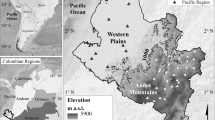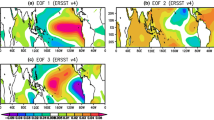Abstract
This study is motivated by the problem of extreme precipitation, which has been severe in the northeastern Pacific Basin. The goal was to calculate, for the core North American monsoon, the trend and return period (RP) of regional extreme precipitation not associated and associated with tropical cyclones (TCs) in teleconnection with the oceanic indices PDO, AMO, and ENSO indicators (SOI, MEI, and ONI). Daily precipitation observations from 48 weather stations were obtained from the CLImate COMputing (CLICOM) system for the time period 1961–2000. Using principal component analysis with oblique rotation, precipitation regions were determined. Extreme precipitation was calculated through the P95 and P99 percentiles. The following were calculated for the P95 and P99 percentiles: (1) non-parametric trend, (2) linear trend, (3) RPs, and (4) standardized precipitation anomalies (Z). The PDO, AMO, and ENSO indicators were obtained from the National Oceanic and Atmospheric Administration. Pearson (rP) and Spearman (rS) correlations between Z and the oceanic indices were calculated. The CNAM contained four precipitation regions. Only R1 had a positive linear trend of P95 not associated with TCs, at a rate of 2.75% decade−1. The +PDO (El Niño) phase influences Z-TCs in R4. Z-TCs in R1 and R2 are only influenced by –AMO (El Niño) phases. Only Z-no TCs showed inverse teleconnection with the +SOI phase in R3. MEI did not have teleconnection with Z. For the +ONI phases (El Niño), no significant Z-TCs were present in R1. From 2020 to 2050, the entire study area will have DEP > P95.







Similar content being viewed by others
References
Aguilera NMA (2007) Estimation of the probability distribution functions, for maximum flows, in the Maule region. Professional Thesis of the TALCA University, Faculty of Forest Sciences, Chile, 154
Azcárate R, Mejía FA (2016) Meteorology, socioeconomics and disaster risk management of the event El Niño-Southern-Oscillation in Colombia. Mutis 2:95–109
Buytaert W, Célleri R, De Bièvre B, Cisneros F, Wyseure G, Deckers J, Hofstede R (2006) Human impact on the hydrology of the Andean páramos. Earth Sci Rev 79:53–72
Camacho SJ (2008) Association between variables: non-parametric correlation. AMC, 3144-146
Cao F, Gao T, Dan L, Xie L, Gong X, (2019) Variability of summer precipitation events associated with tropical cyclones over mid-lower reaches of Yangtze River Basin: Role of the El Niño–Southern Oscillation. Atmosphere 10 (5):256
Castro LC (2019) The North American monsoon: it’s what makes summer weather interesting in the southwestern US. Conference 52
Cattel RB (1966) The Scree test for the number of factors. Multivar Behav Res 1:245–276
CLImate COMputing (CLICOM) database (2017) Available online: http://clicom-mex.cicese.mx/mapa.html (accessed on 27 January 2017)
Climate prediction center/national centers for environmental prediction (CPC/NCEP) (2015) ENSO: Recent Evolution, Current Status and Predictions
Crimmins AM (2006) Arizona and the North America monsoon system. The University of Arizona, 8.
Cruz RJ, Rivas D, Tejeda MA (2015) Variability of surface air temperature in Tampico, northeastern Mexico. Int J Climatol 35:3220
Diaz SC, Salinas ZCA, Hernández VS (2008) Variability of rainfall from tropical cyclones in northwestern Mexico and its relation to SOI and PDO. Atmósfera 2:213–223
Enfield D, Mestas-Nunez AM, Trimble PJ (2001) The Atlantic multidecadal oscillation and its relation to rainfall and river flows in the continental U.S. Geophys Res Lett 10:2077–2080
Estrella GRD (2018) Estimation of the capacity of the soil to the occurrence of floods associated with periods of return to the riverbanks of the river Fuerte, Sinaloa. Master's Thesis of the Instituto Politécncio Nacional, 115 p. https://www.google.com.mx/url?sa=t&rct=j&q=&esrc=s&source=web&cd=1&ved=2ahUKEwj188bT8NTmAhWGG80KHbZiDQYQFjAAegQIBRAC&url=http%3A%2F%2Fwww.cienciasinaloa.ipn.mx%2Fjspui%2Fbitstream%2F123456789%2F303%2F1%2F16%2520Tesis%2520Rosa%2520Delia%2520Estrella%2520Gastelum.4jNp9c-IJ
González OHA, Cortés CP, Íñiguez DLI, Ortega RA (2014) The natural protected areas of Mexico. Research and Science of the Autonomous University of Aguascalientes 60:7–15
Gutiérrez LJ, Vargas TV, Romero RM, De la Cruz JMP, Aguirre BMJ, Silva EHT (2011) Return periods of torrential rains for the state of Tamaulipas, Mexico. Geographic Researchs, Bulletin of the Institute of Geography, UNAM 76:20–33
Gutzler SD (2004) An index of interannual precipitation variability in the core of the North American monsoon region. American Meteorological Society. Notes and Correspondence 17:4473–4480
Hammer Ø (2015) PAleontological STatistics Version 3.08 Reference manual, 243.
Hare SR, Mantua NJ (2000) Empirical evidence for North Pacific regime shifts in 1977 and 1989. Prog Oceanogr 47:103–145
Hernández SCA (2016) Climatology of the tropical cyclones in the Northeast of the Pacific Ocean. Professional Thesis of National Autonomous University of Mexico, 79.
Hernandez AJJ, Matyas CJ (2016) Tropical cyclone rainfall over Puerto Rico and its relations to environmental and storm–specific factors. Int J Climatol 36:2223–2237
Hossein T, Willems P (2016) Daily precipitation extremes in Iran: decadal anomalies and possible drivers. J Am Water Resour Assoc 2:1–19
Hunink JE, Immerzeel WW, Droogers P (2013) Analysis of spatial patterns of precipitation in the province of Tungurahua. Tungurahua Provincial Government, Ecuador 43
Image (2017a): Available online: https://www.google.com.mx/search?q=rc3ados-y-presas-en-sonora&tbm=isch&source=iu&ictx=1&fir=KkmQcmUYeBmmOM%253A%252COtUPb-UIUIOBMM%252C_&usg=AI4_-kSQ7mJtFNrI1SYTiEbInokoIMkmqQ&sa=X&ved=2ahUKEwj1nuWFkpHgAhUnwVQKHdbLChEQ9QEwAnoECAUQBA#imgrc=KkmQcmUYeBmmOM: (accessed on 28 March 2017).
Image (2017b): Available online: https://www.google.com.mx/search?tbm=isch&sa=1&ei=1k5PXMWBO8OZ0wLQwLTQDg&q=map1-2%2BSinaloa&oq=map1-2%2BSinaloa&gs_l=img.3...4173.5648..6127...0.0..0.212.1547.0j7j1......1....1..gws-wiz-img.Z-Vz0GBFPS0#imgrc=PPxYLmT7mgGbKM: (accessed on 17 March 2017).
Image (2017c): Available online: https://www.google.com.mx/search?tbm=isch&sa=1&ei=3k5PXISEK4_9_wSc8JSIBg&q=250px-Chihuahua_Hidrografia_Primitiva&oq=250px-Chihuahua_Hidrografia_Primitiva&gs_l=img.3...35146.35146..35553...0.0..0.186.186.0j1......1....2j1..gws-wiz-img.xvm_cFXVSF0#imgrc=7R3Bqm3c6jaqXM: (accessed on 12 February 2017).
Kendall MG (1975) Rank correlation methods. Charles Griffin, London
Koutsoyiannis D (2003) On the appropriateness of the Gumbel Distribution in modeling extreme rainfall, Proceedings of the ESF LESC Exploratory Workshop held at Bologna, Italy, 303:24–25
Larson J, Zhou Y, Higgins RW (2005) Characteristics of landfalling tropical cyclones in the United States and Mexico: climatology and interannual variability. J Clim 18:1247–1262
Llanes CO, Norzagaray CM, Muñoz SNP, Ruiz GR, Troyo DE, Álvarez RP (2015) Hydroclimatic trends in areas with high agricultural productivity in northern Mexico. Pol J Environ Stud 3:229–239
Llanes CO, Gaxiola-Hernández A, Estrella-Gastelum R, Norzagaray-Campos M, Troyo-Diéguez E, Pérez-González E, Ruiz-Guerrero R, de J. Pellegrini Cervantes E, (2018) Variability and factors of influence of extreme wet and dry events in Northern Mexico. Atmosphere 9 (4):122
Mantua NJ, Hare SR, Zhang Y, Wallace JM, Francis RC (1997) A Pacific interdecadal climate oscillation with impacts on salmon production Bull. Amer Meteor Soc 78:1069–1079
Matías RLG (2013) Cyclonic precipitation as a natural risk. Phd Thesis of National Autonomous University of Mexico, 130.
Méndez M, Magaña V (2010) Regional aspects of prolonged meteorological droughts over Mexico and Central America. Journal of Climate 23 (5):1175–1188 https://doi.org/10.1007/s00704-019-03003-7
National oceanic and atmospheric administration (NOAA) database (2017a): Available online: http://www.nhc.noaa.gov/pastall.shtml (accessed on 11 February 2017).
National oceanic and atmospheric administration (NOAA) database (2017b): Available online: http://www.cdc.noaa.gov (accessed on 5 February 2017).
National water commission (CONAGUA) (2004) Statistics on Water in Mexico, 2nd ed., chap. 3-4, national water comission, Mexico City, 101.
National water commission (CONAGUA) (2017a) database: Available online: http://smn1.conagua.gob.mx/ciclones/historia/ciclones1970-2011.pdf (accessed on 20 February 2017).
National water commission-national meteorological service (CONAGUA-SMN) database (2017b): Available online: http://peac-bc.cicese.mx/datosclim/dcbc.php (accessed on 15 March 2017).
Norzagaray CM, García GC, Muñoz SP (2009) Natural-anthropogenic impact on the flow and piezometric levels of the Sinaloa river aquifer. Latin American Journal of Natural Resources 3:212–218
Norzagaray CM, Muñoz SP, Espinosa CL, Ruíz GR, González OH, Llanes CO (2016) Erosivity indicators based on rainfall in Northwestern Mexico. J Environ Eng Landsc Manag 2:133–142. https://doi.org/10.3846/16486897.2015.1106405
Ojeda BW, Sifuentes IE, Unland WH (2006) Integral programming for corn irrigation in Northern Sinaloa, Mexico. Agrociencia 40:13–25
Ormaza GFI (2016) High and low frequency oceanographic events in the East Equatorial Pacific Ocean. Evaluation of its monitoring and prediction Revista Internacional de Investigación y Docencia (RIID) 2:2445–1711
Ozger M (2017) Assessment of flood damage behavior in connection with large-scale climate indices. J. Flood Risk Management 10:79–86
Pedhazur EJ (1997) Multiple regression in behavioral research, 3rd edn. Harcourt Brace, Orlando
Pedrosa I, Juarros BJ, Robles FA, Basteiro GCE (2015) Goodness of fit tests in symmetric distributions, what statistic to use? Universitas Psychologica 1:15–24
Press WH, Teukolsky SA, Vetterling WT, Flannery BP (1992) Numerical recipes in C. Cambridge University Press, 949.
Quevedo RF (2011) Normal distribution. Statistics applied to health research, XI 5:1–5
Ramoni PP (2016) Modeling of the spatial distribution of the average monthly precipitation of the Venezuelan Andes. Master’s Thesis at the University of Los Andes, 160.
Richman MB, Lamb PJ (1985) Climatic pattern analysis of three- and seven-day summer rainfall in the central United States: some methodological considerations and a regionalization. J Clim Appl Meteorol 24:1325–1343
Rojas E, Arce B, Peña A, Boshell F, Ayarza M (2010) Quantification and interpolation of local temperature and precipitation trends in high Andean zones of Cundinamarca and Boyacá (Colombia). Revista Corpoica – Ciencia y Tecnología Agropecuaria 2:173–182
Seastrand S, Serra Y, Castro C, Ritchie E (2014) The dominant synoptic-scale modes of North American Monsoon precipitation. Int J Climatol 35:2019–2032. https://doi.org/10.1002/joc.4104
Secretariat of Agriculture, Livestock, Rural Development, Fisheries and Food (SAGARPA) (2015) Agricultural technical agenda of Sinaloa, second Edition, 242 p.
Sen PK (1968) Estimates of the regression coefficient based on Kendall’s Tau. J Am Stat Assoc 63:1379–1389
Soto MC (2003) Commercial agriculture in irrigation districts in Mexico and its impact on agricultural development. Geographic Researchs, Bulletin of the Institute of Geography, UNAM, No 50:173–195
Sven LWC, Silvestre E, Pulache W (2010) Trends in the extremes of rainfall near the city from Cusco and its relationship with the floods of January 2010. Peruvian Journal Geo-Atmospheric RPGA 2:89–98
Tamara PI, Maria AF, Silva D, de Paula DS, Leila MV, Freitas DE (2017) Trends and variability in extremes of precipitation in Curitiba Southern Brazil. Int J Climatol 37:1250–1264
Toshie MK, Buscioli VC (2014) How the Atlantic multidecadal oscillation (AMO) modifies the ENSO influence on the South American rainfall. International Journal of Climatology 34 (1):162–178
Trenberth KE (1997) The definition of El Niño. Bull Amer Met Soc 78:2771–2777
Troyo DE, Mercado MG, Cruz FA, Nieto GA, Valdez CRD, García HJL, Murillo AB (2014) Drought and desertification analysis by aridity indices and estimation of the hydric gap in Baja California Sur, northwestern Mexico. Geographic Researchs, Bulletin of the Institute of Geography, UNAM 66:68–81
Unisys database (2017): Available online: http://weather.unisys.com/hurricane/e_pacific/index.html (accessed on 15 February 2017).
Villarini G, Denniston RF (2016) Short communication contribution of tropical cyclones to extreme rainfall in Australia. Int J Climatol 36:1019
Villasenor AJA, González EE (2009) A generalization of Shapiro-Wilk test for multi-variate normality. Communications in Statistics, Theory and Methods 38:1870–1883
White D, Richman M, Yarnal B (1991) Climate regionalization and rotation of principal components. Int J Climatol 11:1–25
Wolter K (1987) The Southern Oscillation in surface circulation and climate over the tropical Atlantic, Eastern Pacific, and Indian Oceans as captured by cluster analysis. J Climate Appl Meteor 26:540–558
Zhang Y, Wallace J, Battisti D (1997) ENSO-like interdecadal variability. 1900–93(10):1004–1020
Acknowledgments
The authors acknowledge the Secretaría de Investigación y Posgrado of Instituto Politécnico Nacional (SIP-IPN) for support for the multidisciplinary research project with registration code SIP: 20170218.
Author information
Authors and Affiliations
Corresponding author
Ethics declarations
Conflicts of interest
The authors declare that they have no conflict of interest.
Additional information
Publisher’s note
Springer Nature remains neutral with regard to jurisdictional claims in published maps and institutional affiliations.
Rights and permissions
About this article
Cite this article
Llanes-Cárdenas, O., Norzagaray-Campos, M., Gaxiola, A. et al. Regional precipitation teleconnected with PDO-AMO-ENSO in northern Mexico. Theor Appl Climatol 140, 667–681 (2020). https://doi.org/10.1007/s00704-019-03003-7
Received:
Accepted:
Published:
Issue Date:
DOI: https://doi.org/10.1007/s00704-019-03003-7




